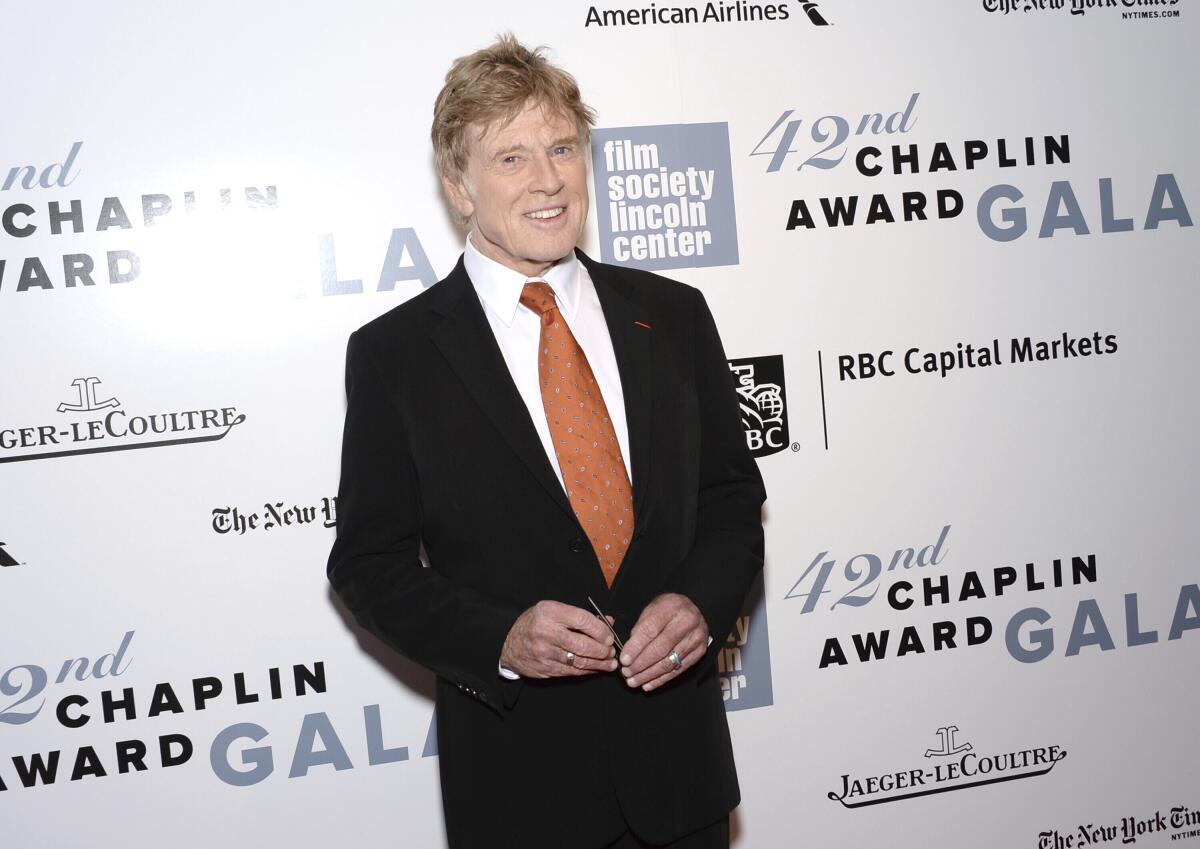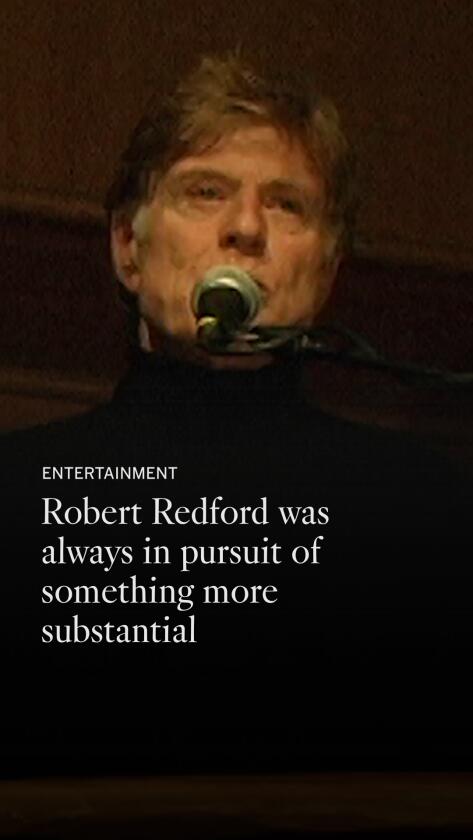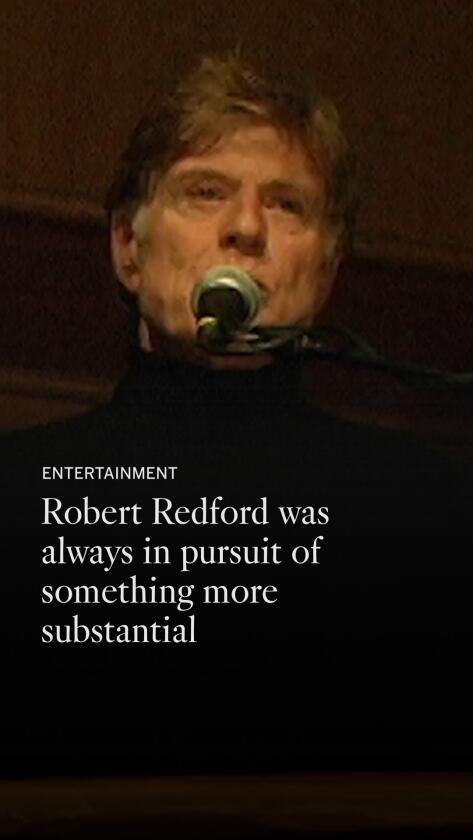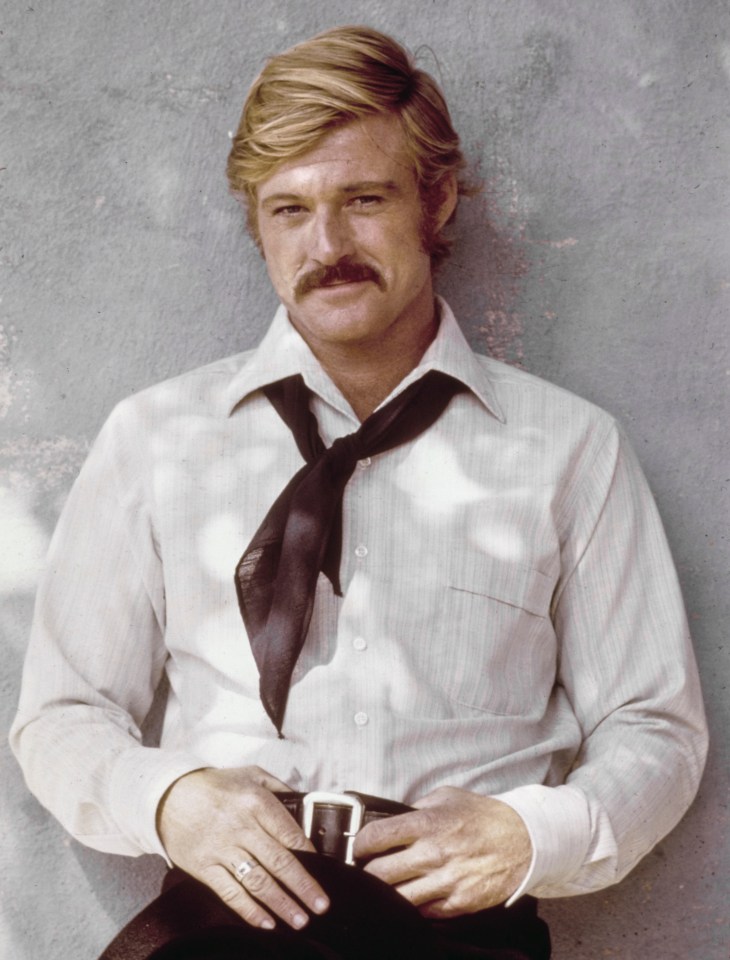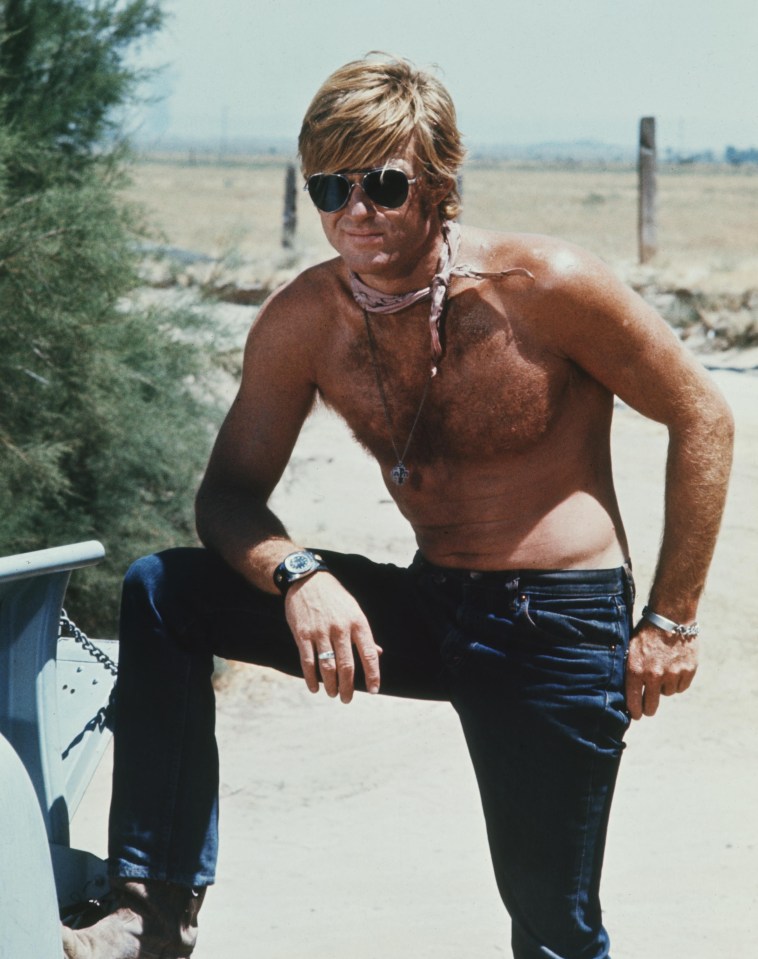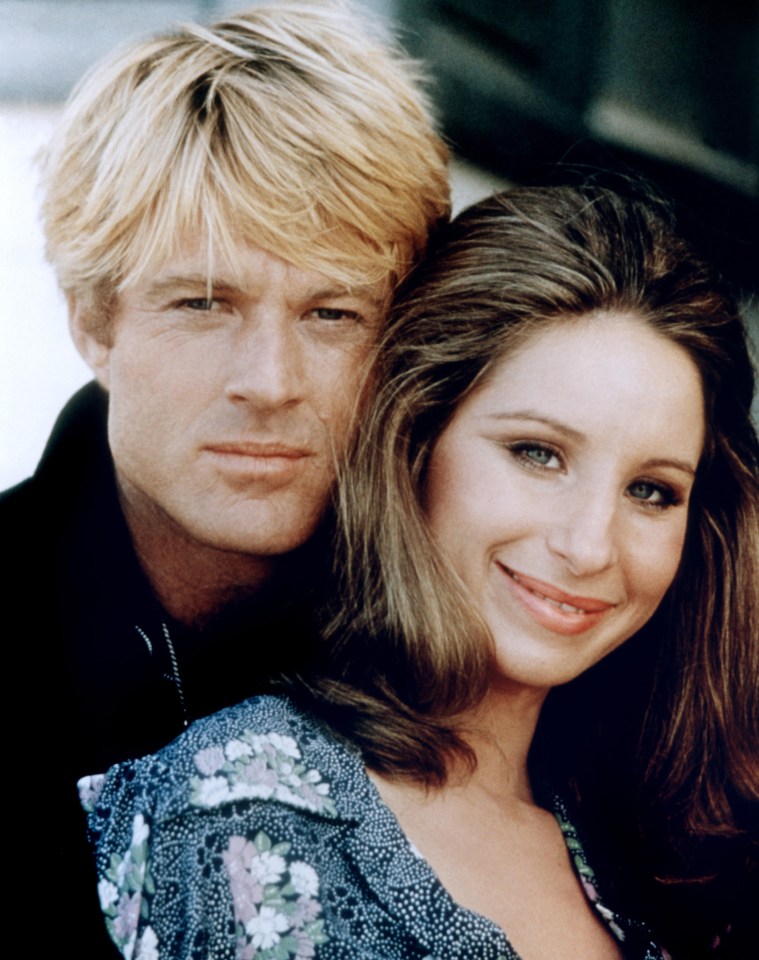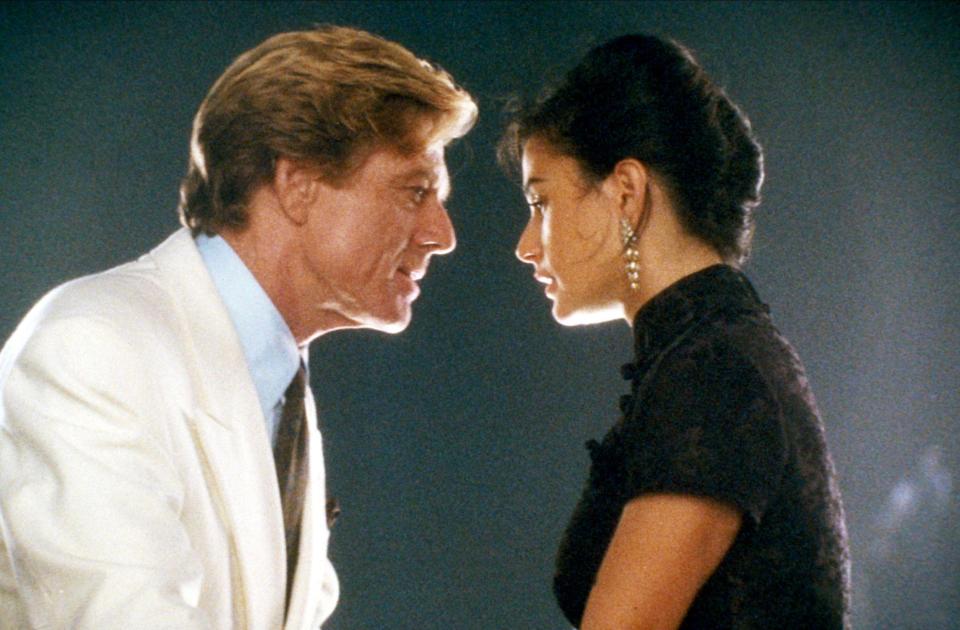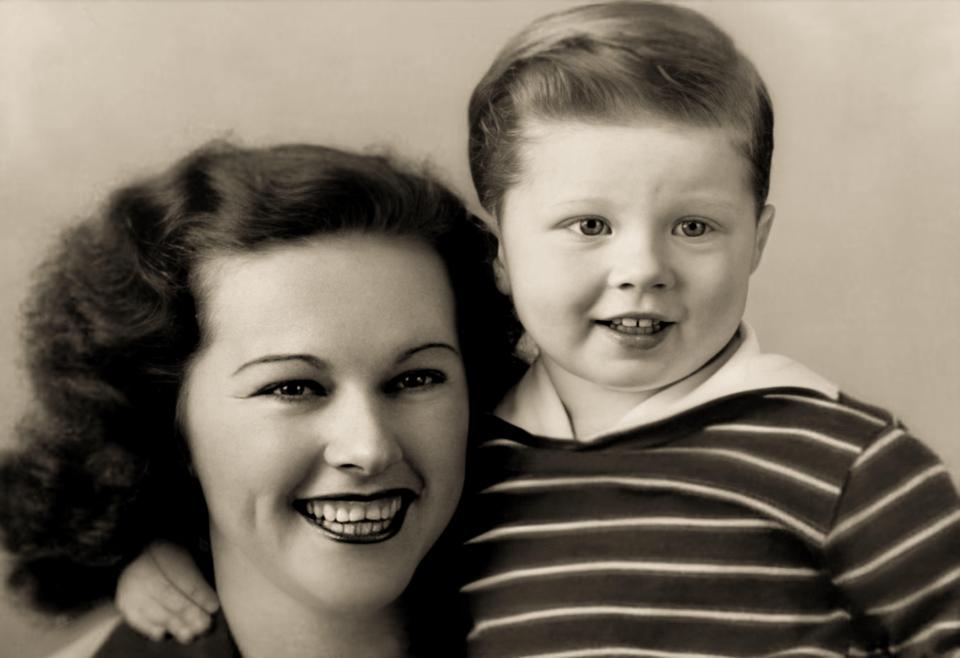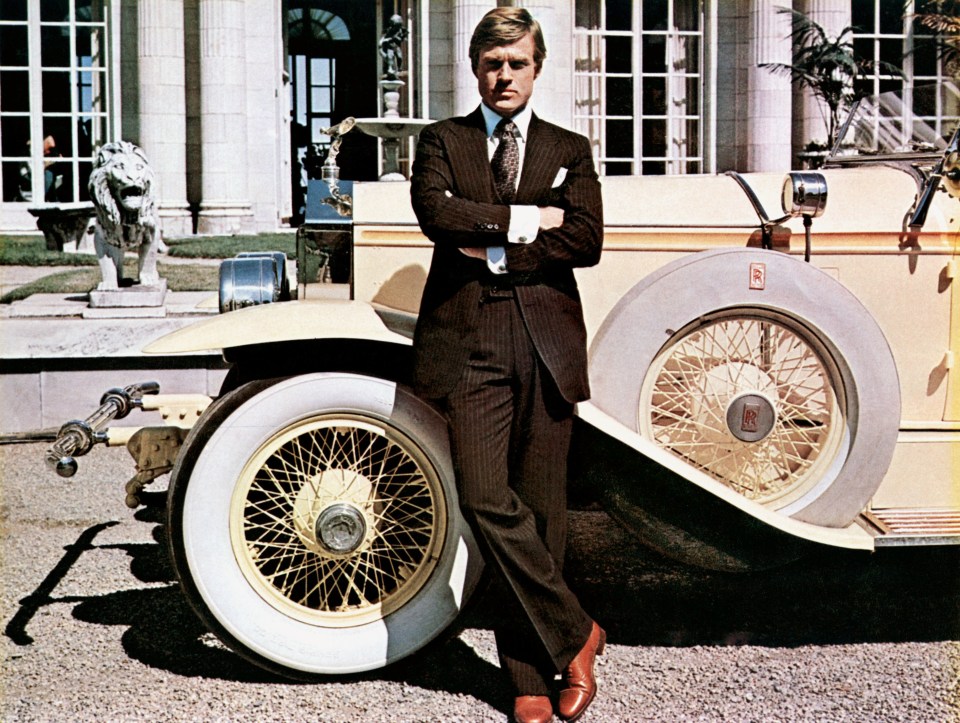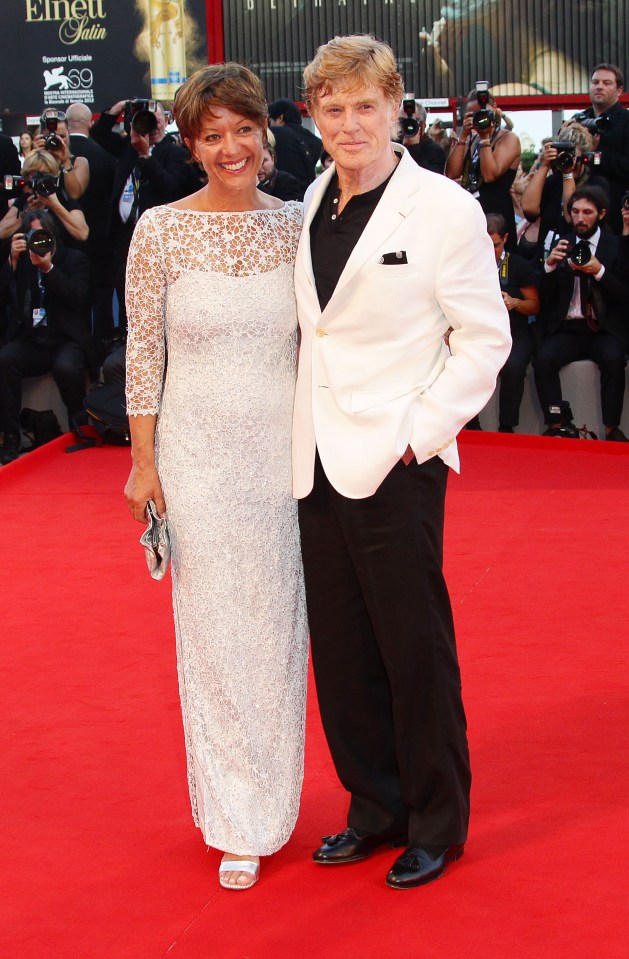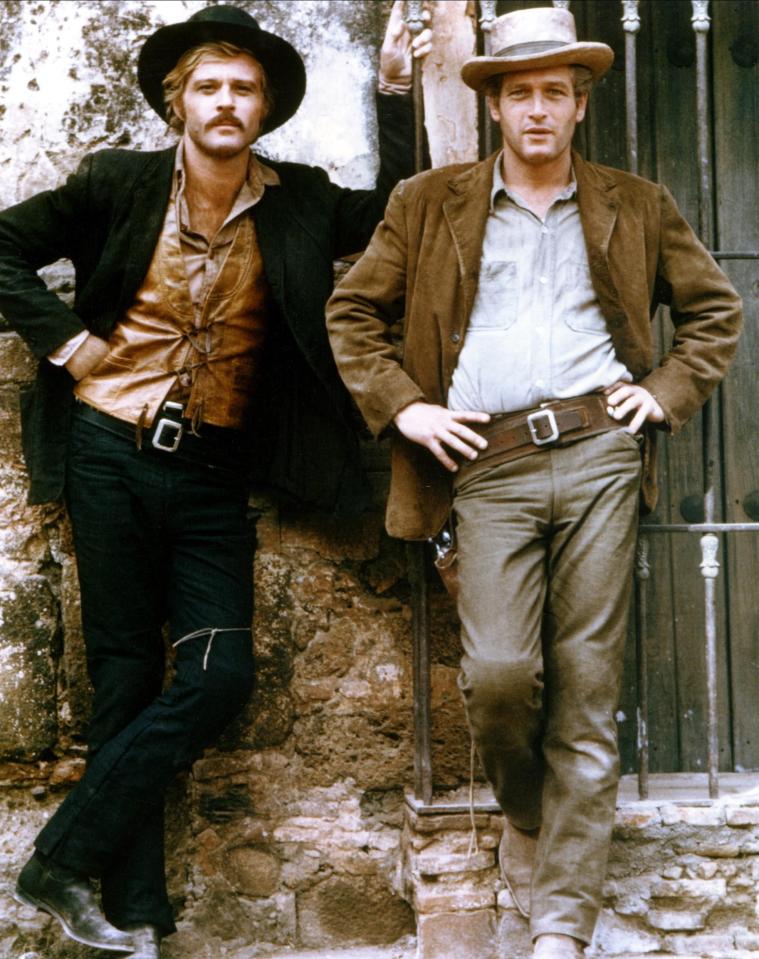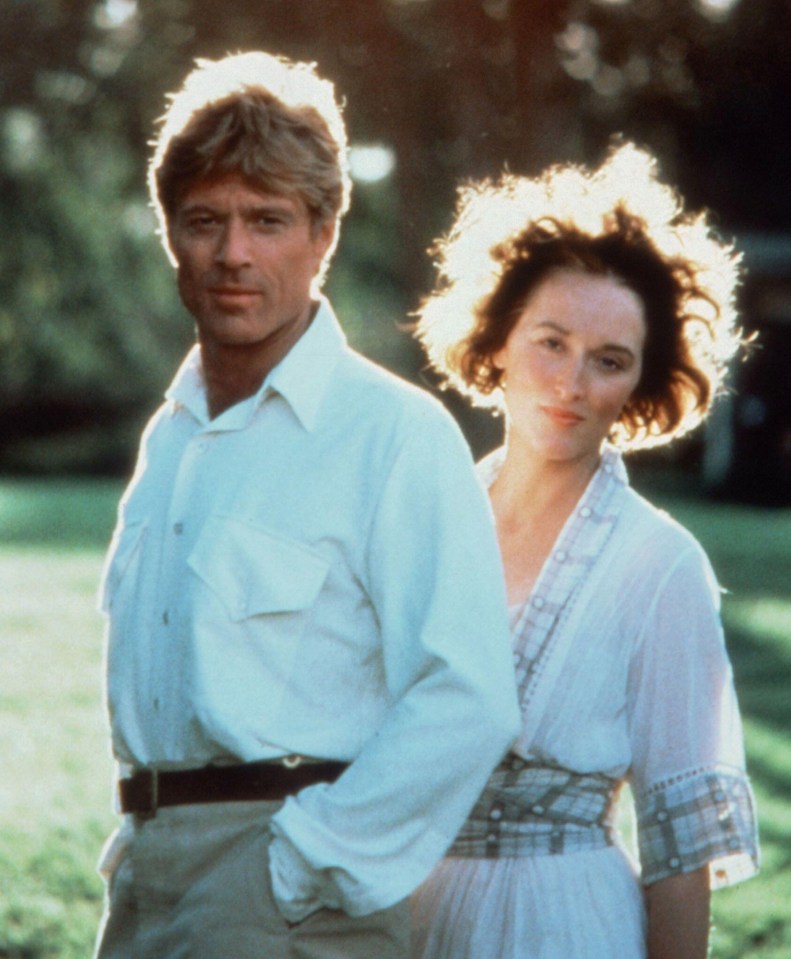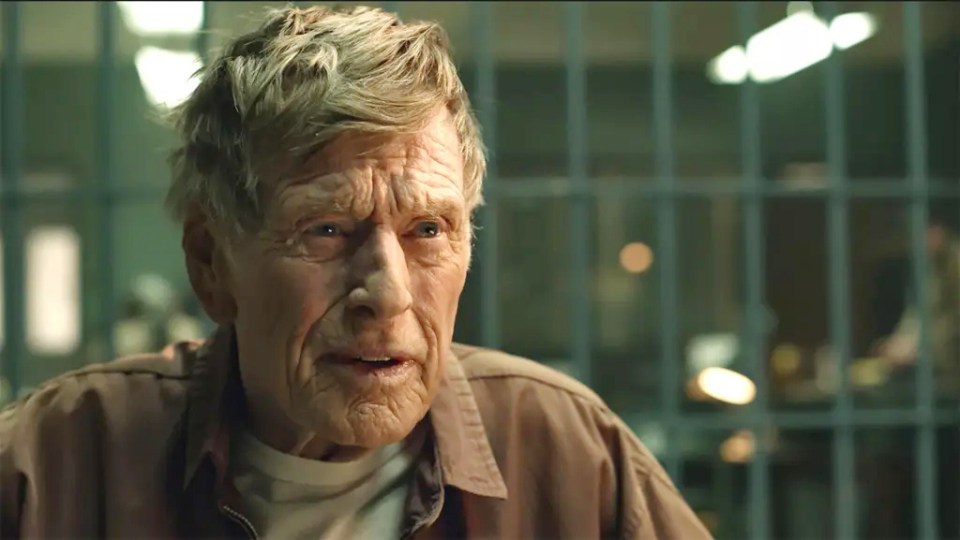Considering Robert Redford’s legacy, plus the week’s best movies
Hello! I’m Mark Olsen. Welcome to another edition of your regular field guide to a world of Only Good Movies.
Robert Redford died this week at age 89 at his home outside Provo, Utah. The actor, producer and director had been a star for more than 60 years, going back to the 1963 comedy “Barefoot in the Park” and covering an enormously long list of performances in films such as “Butch Cassidy and the Sundance Kid,” “The Hot Rock,” “Downhill Racer,” “The Way We Were,” “The Candidate,” “The Sting,” “Three Days of the Condor,” “All the President’s Men,” “The Electric Horseman,” “The Natural” and many more.
Redford was also an accomplished director, winning an Oscar for his debut “Ordinary People” and going on to make films such as “A River Runs Through It,” “Quiz Show,” “The Horse Whisperer,” “The Conspirator” and others.
In a survey of his career, Amy Nicholson wrote, “To appreciate Redford fully, we have to applaud not only the work he did but the simple, feel-good roles he rejected. He could have become a celebrity without breaking a sweat as the war hero, the jock, the husband, the cowboy, the American ideal made incarnate. Yet, he had the rare ability to sidestep what audiences thought we wanted from him to instead give us something we didn’t know we needed: selfish victors (‘Downhill Racer’), self-destructive veterans (‘The Great Waldo Pepper’) and tragic men who did everything right and still failed (2013’s ‘All Is Lost’).”
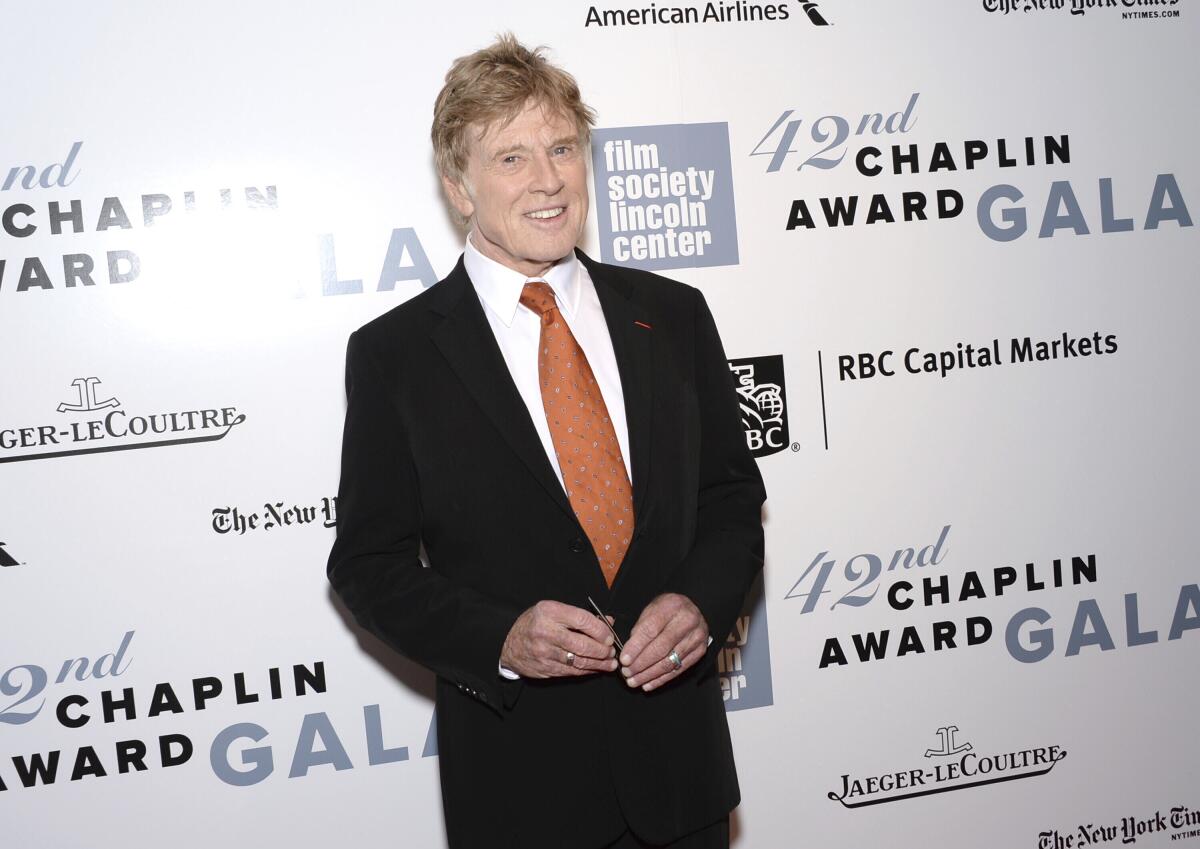
Robert Redford at the Film Society of Lincoln Center in New York in 2015.
(Evan Agostini / Invision / AP)
Nicholson added, “Lately, the Redford roles I’ve been thinking about are the ones where his all-American appeal makes us examine all of America, good and bad. The two that instantly jump to mind are his pair of political thrillers: ‘Three Days of the Condor,’ in which he plays a CIA agent on the run from his own co-workers, and ‘All the President’s Men,’ in which he doggedly uncovers the Watergate scandal. Both films believe in the power of getting the truth out to the press; neither is so naive as to think the truth alone will save the day.”
And then there is a whole other side to Redford: his extensive work as an activist on behalf of environmental causes and his founding of the Sundance Institute, which lead to the creation of the Sundance Film Festival.
I took a look at Redford’s work with Sundance and how he did nothing less than transform Hollywood, carving out a space for independent artists and opening doors for those who had been previously shut out by the industry.
“Mr. Redford was a shining example of how to leverage success into community building, discovery and empowerment,” filmmaker Ryan Coogler said in a statement. Coogler’s own career was launched via Sundance.
“In these trying times it hurts to lose an elder like Mr. Redford, someone who through their words, their actions and their commitment left their industry in a better place than they found it.”
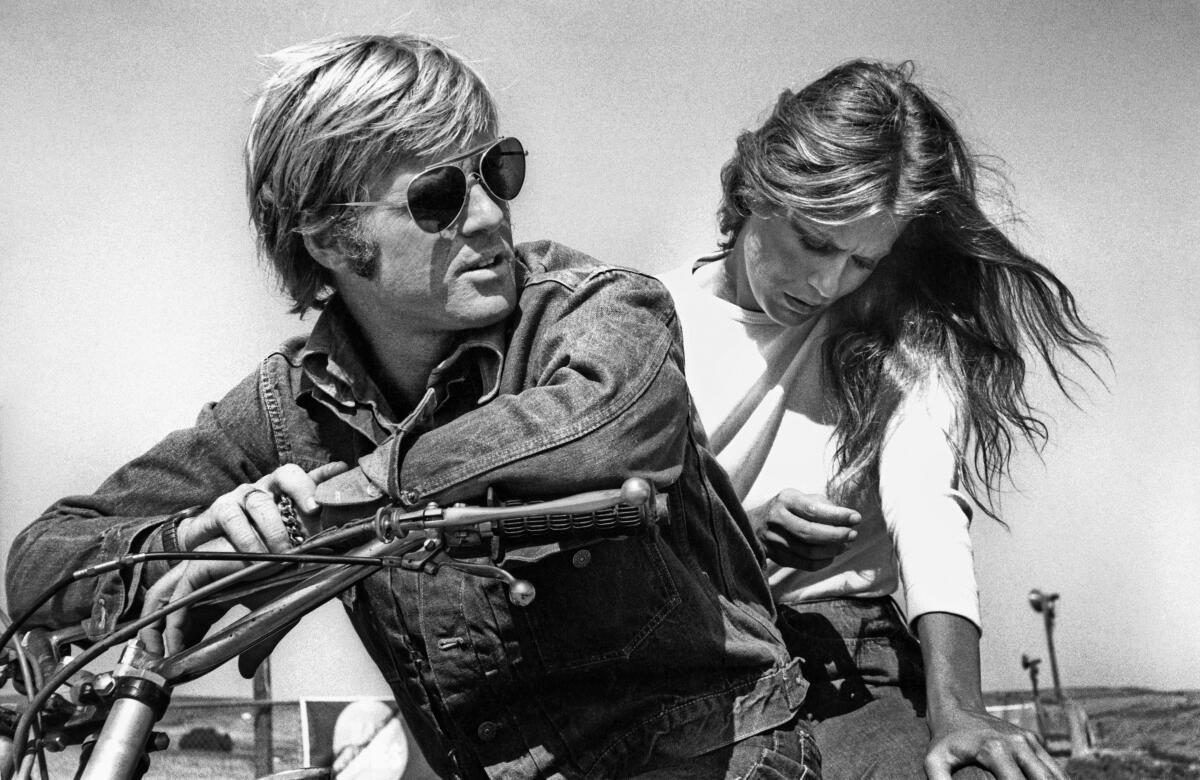
Robert Redford and Lauren Hutton in 1970’s “Little Fauss and Big Halsy.”
(Steve Schapiro / Fahey / Klein Gallery)
I personally met Redford only once, when I moderated a Q&A in 2013 for “The Company You Keep,” in which he starred as a former ’60s radical. It would be the last feature film he directed. I was introduced to him shortly before we were to go in front of an audience together and he wanted to sit and talk for a moment. He immediately asked me about myself, where I was from and how long I had been a journalist.
It was thoroughly disarming to have someone so famous engage with me in a way that felt so genuine. Suddenly he was not a movie star, though he did indeed possess an otherworldly grace, charm and rugged beauty, but rather something even larger, someone who engaged with the world from a place of true curiosity. He leaves a lasting legacy, having touched countless lives.
There will surely be many more tributes and events to come, but Vidiots has already announced a screening of Alan J. Pakula’s 1976 “All the President’s Men,” starring Redford and Dustin Hoffman, on 35mm for Friday, Oct. 3.
‘Mysterious Skin’ in 4K
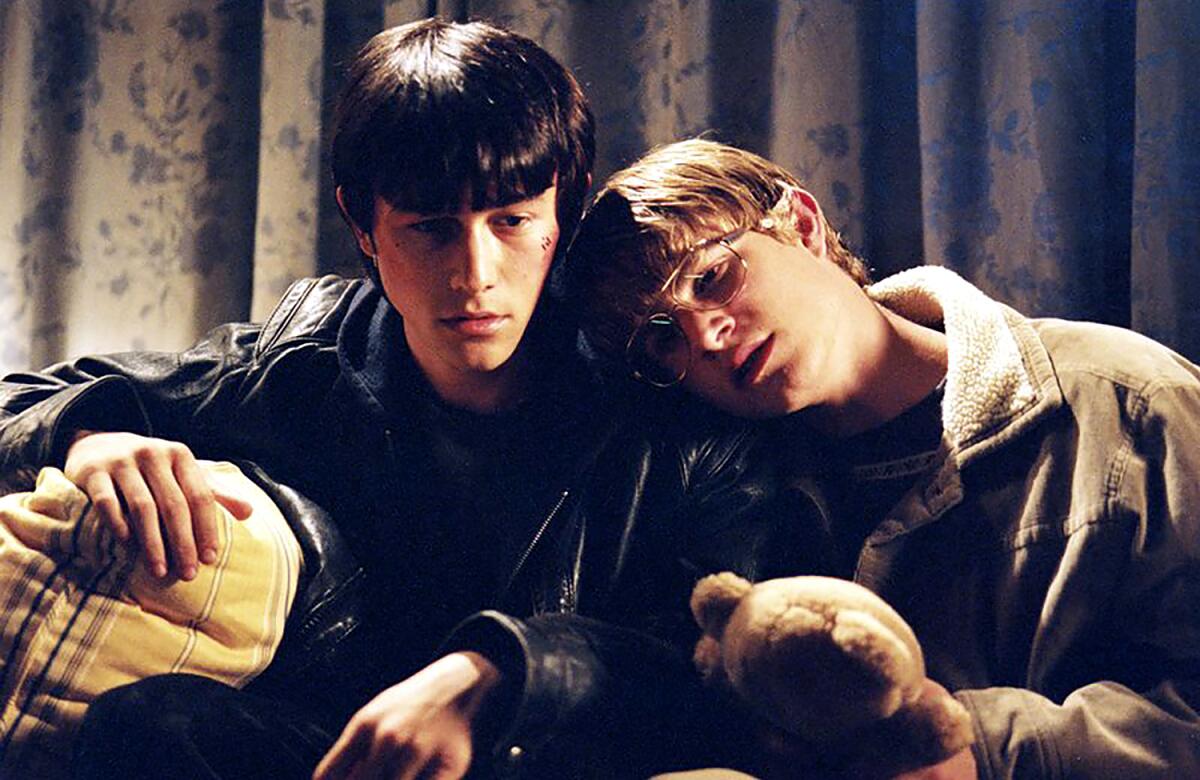
Joseph Gordon-Levitt, left, and Brady Corbet in the movie “Mysterious Skin.”
(Tartan Films)
Seeing the ongoing revival of Gregg Araki’s filmography in restored versions as fans wait for his upcoming film, “I Want Your Sex,” has been very gratifying. Tonight, the Academy Museum will present Araki’s 2004 “Mysterious Skin” in a new 4K restoration followed by a conversation with Araki, actor Joseph Gordon-Levitt and novelist Scott Heim, moderated by “Anora” filmmaker Sean Baker.
“Mysterious Skin” is a delicately told, crushingly disturbing tale of two young men (played by Gordon-Levitt and future “The Brutalist” director Brady Corbet) who each process an incident of sexual abuse from their childhood in different ways. The cast also includes Elisabeth Shue, Mary Lynn Rajskub and Michelle Trachtenberg, who died earlier this year.
Reviewing the film at the time, Kevin Thomas wrote, “The most mature work by the idiosyncratic and gifted Araki, ‘Mysterious Skin,’ based on the book by Scott Heim, highlights the director’s talent for inspiring the most demanding of portrayals from actors and for richly evoking the world his characters inhabit. The film has a mesmerizing floating quality, heightened by Harold Budd and Robin Guthrie’s deceptively serene score, and it has considerable offbeat, deadpan humor to offset its dark undertow. … it’s hard to imagine a more serious or persuasive indictment of the horrors inflicted on children by sexual abuse than ‘Mysterious Skin.’”
I spoke to Araki at the time about the perception that the film was a step toward a new-found maturity following the bratty punk charm of his earlier work.
“I like that it was a real departure for me and that people didn’t expect it,” said Araki. “I really appreciate that aspect of it, that I’ve never done a serious drama before. I do think that the film totally makes sense with all my other movies. There is a thematic similarity and the sensibilities of Scott [Heim] and myself are really attuned to each other. It’s not as if I’ve directed ‘Chicago.’”
J. Hoberman’s avant-garde NYC
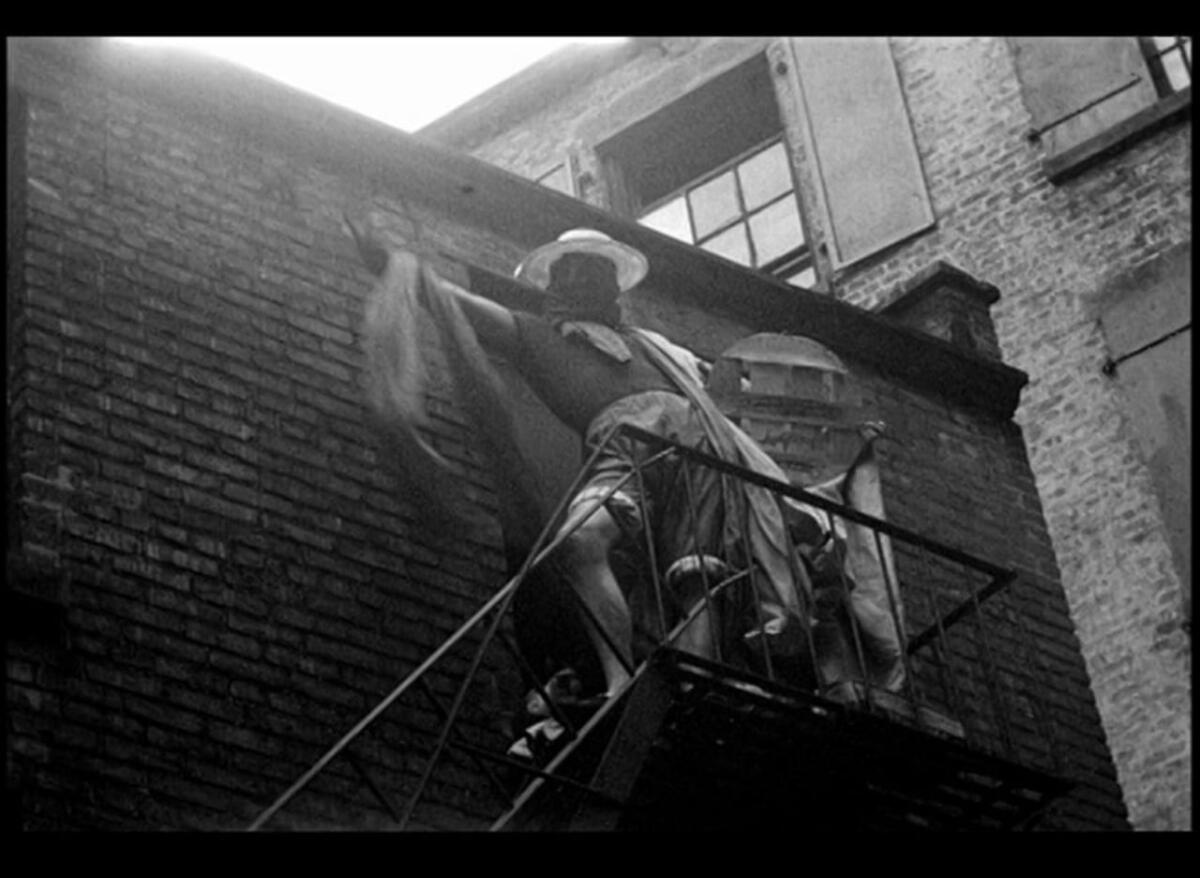
An image from Ken Jacobs’ 1961 “The Whirled (aka Four Shorts of Jack Smith).”
(The Film-makers’ Coop)
On Thursday at 2220 Arts + Archives, Acropolis will present an evening in celebration of J. Hoberman’s inspiring and vivid recent book, “Everything Is Now: The 1960s New York Avant-Garde — Primal Happenings, Underground Movies, Radical Pop.”
Hoberman, formerly the longtime film critic for the Village Voice and an insightful cultural chronicler, will be present for a signing and Q&A along with a program of short films from the era surveyed by the book, when New York was a bubbling cauldron of creativity and restless energy. Titles screening will include Ken Jacobs’ 1961 “The Whirled (aka Four Shorts of Jack Smith),” Ron Rice’s 1962 “Senseless,” Michael Snow’s 1964 “New York Eye and Ear Control” and Jud Yalkut’s 1966 “D.M.T.”
In the introduction to his book, Hoberman explains his thesis of creating a snapshot of a time and place — he pays incredible attention to actual addresses, mapping out what was happening where — by saying, “Cultural innovation comes from the margins and is essentially collective. … New York City in the 1960s was one such cradle of artistic innovation. Boundaries were transgressed, new forms created. A collective drama played out in coffeehouses and bars, at openings and readings, in lofts and storefront theaters and ultimately in the streets.”
Points of interest
Joe Dante’s ‘Pirahna’

A scene from the 1978 movie “Piranha.”
(New World Pictures)
It is always heartening to see longtime local hero Joe Dante celebrated. He will be appearing at Vidiots on Friday, this time with his 1978 film, “Piranha.” Made for producer Roger Corman, the movie was obviously one in a series of films intended to capture the excitement and scares generated by “Jaws,” and it certainly accomplishes that, but it is also so much more.
From a screenplay written by John Sayles, who would go on to an illustrious career as a director himself, and with sharp, smart direction by Dante, “Piranha” is about a mutant strain of killer fish engineered by the military and accidentally released into a small community’s waterways.
Writing about the film in 1978, Charles Champlin said, “‘Piranha’ is what it is: a swift, efficient program picture which squeezes the most out of its dollars to squeeze delicious chills from the audience. But it also plays to the attitudes as well as the emotional needs of its young customers. The bad guys are scientists, the military, the police, the politicians (what were we doing in Vietnam?), authority in almost any uniform.”
Writing about the film in 2012, Dennis Lim added, “This was Dante’s first solo directorial outing after several years at Corman’s New World Pictures, where he got his start editing trailers, and it establishes a distinctive tone that he has sustained throughout his career, right on the line between homage and parody. The actors — several, including [Dick] Miller and [Kevin] McCarthy, who would go on to become frequent Dante collaborators — give performances that are once committed and tongue-in-cheek and the effects, in contrast to the sophisticated animatronics of ‘Jaws,’ are charmingly rough and ready.”
Aaliyah x2

Jet Li and Aaliyah star in “Romeo Must Die.”
(Kharen Hill / Warner Bros. Pictures)
As part of an ongoing Y2K Fridays series, the Gardena Cinema is showing a double-bill of movies starring the late singer and actor Aaliyah, with Andrzej Bartkowiak’s 2000 “Romeo Must Die” and Michael Rymer’s 2002 “Queen of the Damned.”
Riffing on “Romeo and Juliet,” the story of “Romeo Must Die” revolves around Jet Li and Aaliyah as members of warring crime families in Oakland who fall for each other.
Kevin Thomas wrote, “Body counts run high in this genre, but ‘Romeo Must Die,’ which marks Li’s first English-language starring role, tries for some depth and sophistication. … The film is a new step for both Li, who hopes to break out with it, and for recording star Aaliyah, in an accomplished film debut.”

Stuart Townsend and Aaliyah in “Queen of the Damned.”
(Jim Sheldon / Warner Bros. Pictures)
Based on one of the novels from Anne Rice’s popular “Vampire Chronicles,” “Queen of the Damned” stars Stuart Townsend as the vampire Lestat, here taking on the guise of a rock star, and Aaliyah as Akasha, the first vampire.
In his review at the time, Kenneth Turan wrote, “As directed by Michael Rymer and with the late rock star Aaliyah in the title role, ‘Queen of the Damned’ turns out to be a muddled limp biscuit of a movie, a vampire soap opera that doesn’t make much sense even on its own terms. Though the previous film based on Anne Rice’s popular novels, the Tom Cruise-starring ‘Interview With the Vampire,’ was far from a success, this brain-dead venture makes it look like a masterwork by comparison.”
